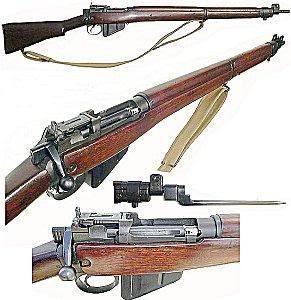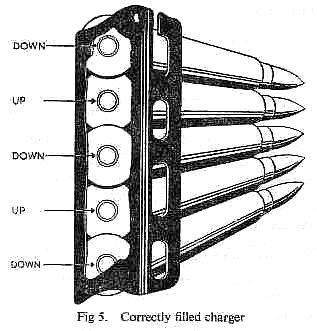 Glory, romance, effectiveness, dogged self-reliance are what come to mind when I lift a British No. 4 rifle. Yes, I like some bolt guns and my favorite is the Lee-Enfield and derivatives. It doesn't hurt that the .303 British cartridge is a great one!
Glory, romance, effectiveness, dogged self-reliance are what come to mind when I lift a British No. 4 rifle. Yes, I like some bolt guns and my favorite is the Lee-Enfield and derivatives. It doesn't hurt that the .303 British cartridge is a great one!.303 British is a rifle and machine gun cartridge first developed in Britain in the 1880s as a blackpowder round, later adapted to use cordite and then smokeless powder propellant. It was the standard British and Commonwealth cartridge from 1889 until the 1950s, when it was replaced by the 7.62 x 51 mm NATO round, and in the 1980s by the 5.56 x 45 mm NATO (.223 in) in most roles. It is a rimmed cartridge and is therefore not entirely suitable for use in modern automatic weapons, but remains popular due to the large number of surplus military rifles chambered for the round which have been released to the civilian market, many of which have subsequently been modified for sporting use.Further, the ballistics of the .303 Brit are very similar to our own .30-40 Krag (.30 Army) and the 7.65x53mm Argentine (Belgian) both of which are among my favorites. They all started a 215-220 gr. bullet at about 2100 fps and or a 174-180 gr. bullet at 2400 fps.
AS to loads, I don't think the powder used is all that important as you simply want the 174 gr. or 180 gr. bullet to start at 2400 fps. I've used IMR 4320, IMR 3031 (made for the .303), IMR and Hogdon 4895, IMR and Hogdon 4350, W748, W760, BL(C)2, and H335. All primers are the standard large rifle type except for the Winchester powders. There are several bullets that will do. I like the Sierra 180 gr. but the 174 gr. Match bullets do well for me, too (however some folks have had problems with boattailled bullets in 2-groove barrels). In reloading the .303 British for my rifles I attempt to duplicate factory ball. That's what the sights are set up for and I do not want to mess with the sights. If I need MORE gun I get more gun. That's 174 gr. @ 2400 fps. In creating loads that do so with minimum pressure and heat I believe I'll lengthen the service life of my rifle(s). In that use it seems to me that no ball powder beat IMR 4350. It gets the required velocity at relatively low pressure and seems to produce less heat in that the barrel doesn't heat up as quickly as with ball powders.
I have tried 150 gr. bullets and the fastest load in friend Mike's No. 4 used IMR 4320 under the Hornady 150 gr. for about 2700 fps. That was accurate and Mike used it at least once to head shoot a doe at a measured (and witnessed) 140 yards using issue stamped version sights. What, if anything, he did to his sights I don't know. The bullets I now use for the .303 British are either the 174 gr. MatchKing or the Sierra 180 gr. SPT.
I have two No. 4 rifles, one Mk I and one Mk I*, and Mike had a MK I*. We took these guns to a good location for 600 yard (and longer) shooting. From a seated position we were easily able to keep a magazine (10 rounds) on the bottom of a 5 gallon bucket at 600 yards. Range was checked with his laser range finder and the 600 yard sight setting was used (and it WORKED!).
Of these rifles, one was a Fazerkly arsenal FTR, one a Longbranch and one (Mike's) a $60 wonder (I don't remember the maker) from the old Rose's department store that had a stock that had obviously seen better days. In fact, he sanded it a bit to keep from getting splinters! Again, this gun was accurate enough that Mike headshot a doe at 140 yards (witnessed).
 Of course if you want to load these guns quickly, you need to have chargers loaded and ready. Still readily available, the chargers have to be loaded a certain way to correctly function. See the illustration to the left.
Of course if you want to load these guns quickly, you need to have chargers loaded and ready. Still readily available, the chargers have to be loaded a certain way to correctly function. See the illustration to the left. We've used several 1¼" slings with these guns but the best sling really is the issue web job. Comfortable, instantly adjustable and durable. There are even reproductions made in Australia that are still reasonably priced for US customers. I'll have to post that link as soon as I find it.
Sights are a concern to many shooters. Not so much with these guns as even the crudest version of the rear aperture sight is plenty good enough. However, I prefer the full capability of the original, milled, sight usable to 2000 some yards. There is also a stamped version of that sight. Of course one could scope these guns and there is a "no modification" scope mount for these guns. But why? I think the aperture sight is fully capable to, as noted, over 600 yards. It would be interesting though...
These guns are relatively inexpensive and so is the ammo. This makes the No. 4 a reasonable TEOTWAWKI armament. Some like the Garands, M14s, M16s or FALs for their ability to put rounds down range without the exercise of working a bolt but the British Enfield will still do the job when necessary.
The .303 British cartridge is an excellent one for sporting use on large game such as deer and black bear. Ballistics with similar weight bullets are very similar to the .300 Savage, .308 Winchester, and .30-40 Krag, without the sometimes objectionable recoil the big magnums sometimes have. The cartridge has indeed been used for hunting since its release and on all North American game as well as many/most of Africa's game animals. It has only come up short on the largest of these.
There are a number of bullets suitable for reloading the .303 British and applicable to a number of uses.
1 - Hornady 150 gr. SP
2 - Sierra Pro-hunter 150 gr. SP
3 - Sierra Matchking 174 gr. HPBT (shoots really well but not applicable to some)
4 - Hornady 123 gr. SP
5 - Hornady 123 gr. FMJ (good for furbearers where legal)
6 - Sierra 180 gr. SP (my personal favorite in the .303 Brit)
7 - Hornady 174 gr. RN
8 - Speer Hot-cor 123 gr. SP
9 - Speer Hot-cor 150 gr. SP
10 - Sierra 125 gr. SP
11 - Hornady 174 gr. FMJ
12 - Speer 180 gr. RN
13 - Woodleigh 215 gr. RN (an outstanding bullet)
14 - Remington 180 gr. RN
15 - Barnes Triple-X 150 gr. Spire Point
16 - Woodleigh 174 gr. PP
I'd like to point out that in WWI, the Germans were convinced (when attacking British lines) that they were running into machinegun positions. This was due to the rate of fire from the SMLEs. Here's a video to give you an idea of what was possible.
Now this video is from R. Lee Ermey's new show on the History Channel. Part of the shooting is with a No1 MKIII.
Links:
- 303british.com
- Enfield King






















No comments:
Post a Comment